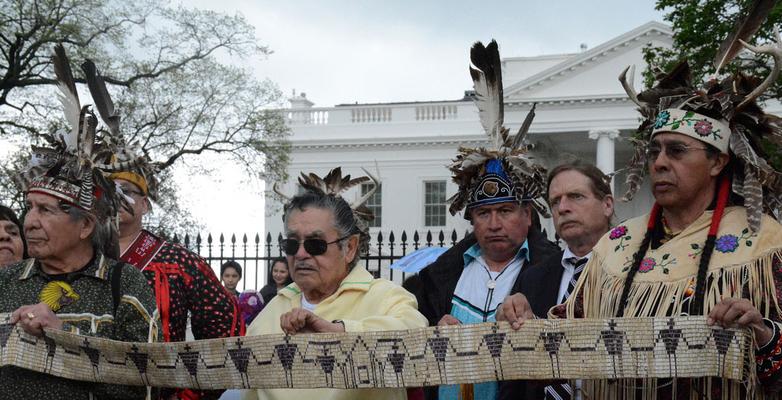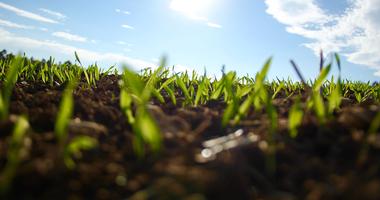
The Canandaigua Treaty: Acknowledging the Past Will Shape our Future
The Canandaigua Treaty of 1794 highlights the importance of Indigenous land stewardship in climate activism and leadership.
By Sophia Powless
The climate crisis has made us reflect on how we can come together and change our behaviors for the betterment of the environment and humanity. Though in order to move forward, there needs to be an acknowledgement of the past and a reflection of our relationships to the planet.
Today, the eleventh day of November, marks the 228th anniversary of the Canandaigua Treaty of 1794, establishing peace and friendship between Haudenosaunee (“People of the Long House”) and the United States. This treaty was signed by leaders of the Haudenosaunee, President George Washington, and ratified by the United States Senate. Within this treaty, it granted the Haudenosaunee land rights to territory in New York State. The treaty also recognized the sovereignty of the Six Nations to govern and set laws as individual nations.
A line that remains significant to this day is lies within Article IV of the Canadaigua Treaty of 1794.
This article states, "The United States having thus described and acknowledged what lands belong to the Oneidas, Onondagas, Cayugas, and Senecas, and engaged never to claim the same, nor to disturb them, or any of the Six Nations, or their Indian friends residing thereon and united with them, in the free use and enjoyment thereof.”
This statement of “Free use and enjoyment” of land has been integrated into the culture of the Haudenosaunee for hundreds of years. The Haudenosaunee are bonded through a united purpose to live in harmony and give thanks for community, nature, and the Creator. This acknowledgement of land rights and sovereignty provides Haudenosaunee nations the opportunity and power to create communities that are dedicated to the purpose of environmental land stewardship.
Free Use and Enjoyment of Land
The traditions, culture, and values surrounding Indigenous communities and the environment are frequently discussed and praised. Living off the land and maintaining balance with Mother Earth has become a mantra for many people. Though those who belong to these communities know that this connection and respect goes deeper. The environment is an extension of oneself, and like someone who cares and loves a family member, the same emotions are felt for Indigenous nations and their lands. To believe that humans have superiority over other life forms does not align with the responsibility of being Oñgwehoñwe’ or “the Real People.”
When you create a barrier between humans and the world, there is an imbalance. Individuals begin to take without thought of the consequence. Indigenous communities are taught that although they are the protectors, they do not have ownership over Mother Earth.
They are a part of a scared circle; the resources, animals, and plants were there before they were born and will remain after they return to the Earth. These teachings highlight the value of every individual and their role and recognize that the opportunity to be alive is something to be thankful for.
The enjoyment of land means the accruement of traditional medicine and foods, paying respect to the gifts from nature that are needed to survive, and having the ability to pass on those gifts to the next generation. This philosophy, also known as the Seventh Generation Principle, is being widely integrated into today’s climate action. It demonstrates the significance our choices on energy, natural resources, water, and consumption have on our youth as well as the next generation. Everyone has the right to enjoy the gifts that the planet provides, and if we are to integrate this principle in our lives, it can create a culture of responsibility and respect for life.
Broken Promises and Broken Lands
History has not respected the bond between Indigenous communities and their connections to their lands. Throughout its 228-year history, there have been countless violations of the Canandaigua Treaty, leaving the Haudenosaunee’s lands a fraction of what it was in the 18th century. Unfortunately, this not the only treaty violation and many nations are familiar with the consequences of promises not being upheld. Indigenous communities across the United States have lost 98.9% of their historical land base and more than 40% of tribes currently possess no federally recognized land. This issue is felt for hundreds of Indigenous nations across the globe, as they also fight the same battle for land rights and acknowledgement.
When we examine the parallels between the climate crisis and Indigenous land, it tells a heartbreaking story of loss and trauma. The loss of wetlands, forests, biodiversity, and freshwater resources are also represented in a loss of language, culture, and sense of self. Indigenous communities conduct their lives around creating a healthy relationship with the environment; and climate change poses a risk to that cultural identity. After all, how can one create a connection with something that no longer exists?
The rate of displacement, land degradation, and deforestation is on an unprecedented scale hurling us toward irreversible climate change. Land that once was seen flourishing with diversity is being replaced with the reality of extinction. With 80% of the world’s remaining biodiversity belonging to Indigenous communities, it is evident that their voice is crucial in the global fight against climate change.
Moving Forward Side by Side
On this anniversary of the Canandaigua Treaty, we welcome a time of reflection and look to correct of the wrongs of previous eras. Treaties have been shown to be powerful when both parties set them to work. They serve as a reminder to both Indigenous and non-Indigenous parties of the importance of land acknowledgement and our relationships to one another. There is much to be learned from the connection and obligations Indigenous communities have with the Earth.
This past June brought a sign of hope. New York State and the federal government brought forth a historic agreement to restore more than 1,000 acres of forest to the Onondaga Nation, including the head waters of the stream that travels through the home of the Onondaga and into Onondaga Lake.
The world now must decide whether this becomes a catalyst for an era of climate action or another missed opportunity.
Get Involved
To learn more about the Canandaigua Treaty of 1794 and this year’s celebration, visit https://ganondagan.org/.
For more information about land rights and the Land Back Movement, click here and here.
Sophia Powless is Wolf Clan from the Onondaga Nation and grew up with a passion for environmental and Indigenous issues, specifically land rights, sovereignty, and environmental justice. She has earned her BA in environmental studies and was a part of the inaugural class of the Columbia Climate School, obtaining a Master of Arts in climate and society. Sophia aims to spread awareness of Indigenous teachings and culture to raise the voices of her community within the climate field. She enjoys expressing herself through art and beadwork and hopes to continue to educate others on the impacts of climate change.
Join our email list today:




